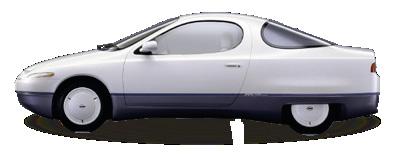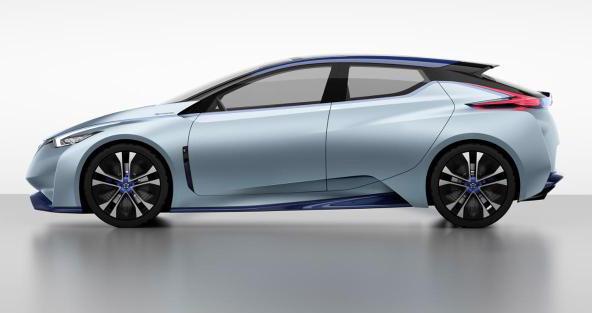
5 minute read
THE EV EVOLUTION
1947: Tama EV Tokyo Electro Automobile Co develops a Tama car and truck in response to a gasoline shortage. In 1951, Tama merged with Prince Motor, which in 1966 became part of Nissan.
May 2016: Vehicle-to-grid trials begin Nissan and Enel announce a major new project to trial vehicle-to-grid charging in the UK for the first time. 1970: Nissan 315X EV city concept The Nissan 315X, a bubble-shaped 56mph two-seater electric city car with a single motor powering the rear wheels, debuts at the Tokyo Motor Show.
Advertisement
March 2016: ‘Fuel Station of the Future’ unveiled at Geneva Incorporating a range of pioneering Nissan technologies, the vision showcases how V2G, battery storage, wireless charging, autonomous drive technology and over-theair connectivity could combine to revolutionise how energy is used and distributed.
June 2017: BladeGlider prototype debuts at Festival of Speed BladeGlider makes first public appearance in Europe at the Goodwood Hillclimb.

September 2017: All-new Nissan LEAF unveiled The second generation LEAF is introduced, showcasing two new technologies: the ProPILOT advanced driver assistance system and e-Pedal, which enables the driver to accelerate and brake to a full stop by moderating just the accelerator. 1983: Nissan March EV The March EV is the first car to use an electric propulsion system with an induction motor and two-speed electromagnetic transmission, giving a range of 100 miles at a constant 25mph.
February 2016: Nissan LEAF 30kWh goes on sale in Europe New battery gives a 26% increase in driving range and only increases weight by 21kg. 1991: FEV concept car The FEV (Future Electric Vehicle) concept debuts with an aerodynamic shape and spacious interior. The short-range vehicle uses heat-pump air conditioning and has a heat-insulated, waterbeading windshield that blocks ultraviolet rays and improves visibility.


October 2015: IDS concept launches at Tokyo Motor Show The IDS showcases Nissan’s vision for a long-range, lightweight 100% electric vehicle that has autonomous driving technology.
October 2017: Nissan announces entry into FIA Formula E Championship Nissan confirms it will become the first Japanese automotive brand to compete in the all-electric FIA Formula E racing championship starting in 2018. October 2017: Nissan IMx concept The Nissan IMx, an all-electric crossover offering fully autonomous operation and a driving range of more than 370 miles, is unveiled at the Tokyo Motor Show.

1995: FEV II concept car Nissan introduces its first concept car to use lithiumion batteries, promising highdensity, light weight and long battery life.
December 2014: Nissan LEAF owners drive collective 1bn km In their first four years Nissan LEAFs registered on CarWings telematics reach a milestone of one billion zero-emission kilometres.
January 2018: Real-world V2G trials Nissan enters into two realworld vehicle-togrid trial projects with Innovate UK alongside OVO Energy and E.ON.
2005: PIVO concept PIVO examines electric vehicle potential. Its most distinctive feature is a cabin that revolves 360-degrees, eliminating the need to reverse. A compact lithium-ion battery powers two electric super motors.
2007: Mixim concept The Mixim combines an electrified powertrain with the latest computer technology to attract younger drivers.
May 2014: e-NV200 production starts Production of the 100% electric e-NV200 compact van begins, ready for sales to start in June.

Jan 2014: Nissan LEAF hits 100,000 sales globally The 100,000th all-electric Nissan LEAF is bought in the UK. It remains the best-selling EV, with a 45% market share. 2008: NUVU prototype The compact NUVU (new view), showcases Nissan’s vision for the future of electric cars. It has 2+1 seating and roof solar panels to help charge the lithium-ion battery. 2009: Nissan Land Glider concept Nissan explores new forms of zero-emission mobility that could redefined existing segments. The result is a radical new concept vehicle with a unique two-seater, cocoonlike structure.
2010: Nissan LEAF launched in USA and Japan Sales of the Nissan LEAF begin in the USA and Japan. In the same year, it becomes the first electric car to gain the prestigious European Car of the Year award.
2013: Nissan LEAF production begins at Sunderland After a refresh, the LEAF begins production at Nissan’s Sunderland plant alongside the Juke and Qashqai.
2012: Nissan LEAF takes record for the fastest car over a mile in reverse Stunt driver Terry Grant showcases the flexibility of the LEAF’s electric powertrain by setting a world record at the Goodwood Festival of Speed for covering a mile in reverse. It travelled 1.16 miles, uphill, in 1 minute and 57 seconds.
2011: Nissan LEAF launched in Europe and wins World Car of the Year Nissan LEAF is named World Car of the Year at the New York International Auto Show. In the same year European sales begin.
March 2018: New Nissan LEAF is World Green Car of Year The new Nissan LEAF became the first 100% EV to be named World Green Car at the 2018 New York International Auto Show. June 2018: Excellence in Climate Solutions Award Nissan wins the Excellence in Climate Solutions Award for its pioneering work to develop EV technology and energy services systems. September 2018: Longer range e-NV200 launched A 40kWh battery means the Nissan e-NV200 extends its range up to 187 miles.

January 2019: Nissan LEAF e+ available in Europe The latest versions of the successful Nissan LEAF family are now available to buy throughout Europe, including the longer-range LEAF e+ –up to 239 miles (WLTP) on a single charge – which had received 8,000 pre-orders since its reveal. September 2019: Nissan and EDF partner on smart charging Nissan and EDF Group sign a cooperation agreement to accelerate the delivery of electric mobility – particularly through smart charging.
Nissan e-NV200 & Nissan LEAF: Fuel consumption figures: CO2 while driving: 0mpg. Figures shown are for comparability purposes; only compare figures with vehicles tested to the same technical procedures. The electric range shown achieved using the new (WLTP) test procedure. Figures obtained after the battery was fully charged. Actual real world driving results may vary dependent on factors such as the starting charge of the battery, accessories fitted after registration, weather conditions, driving styles and vehicle load.










